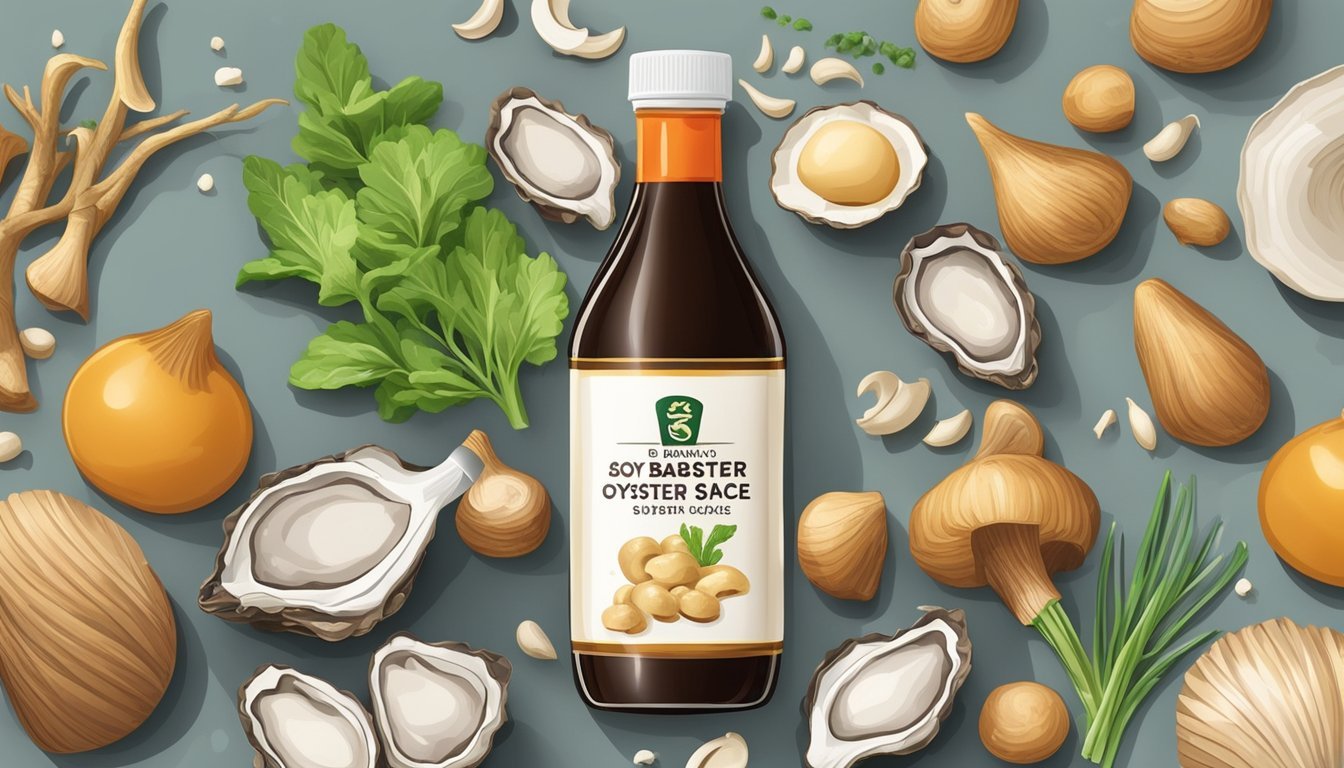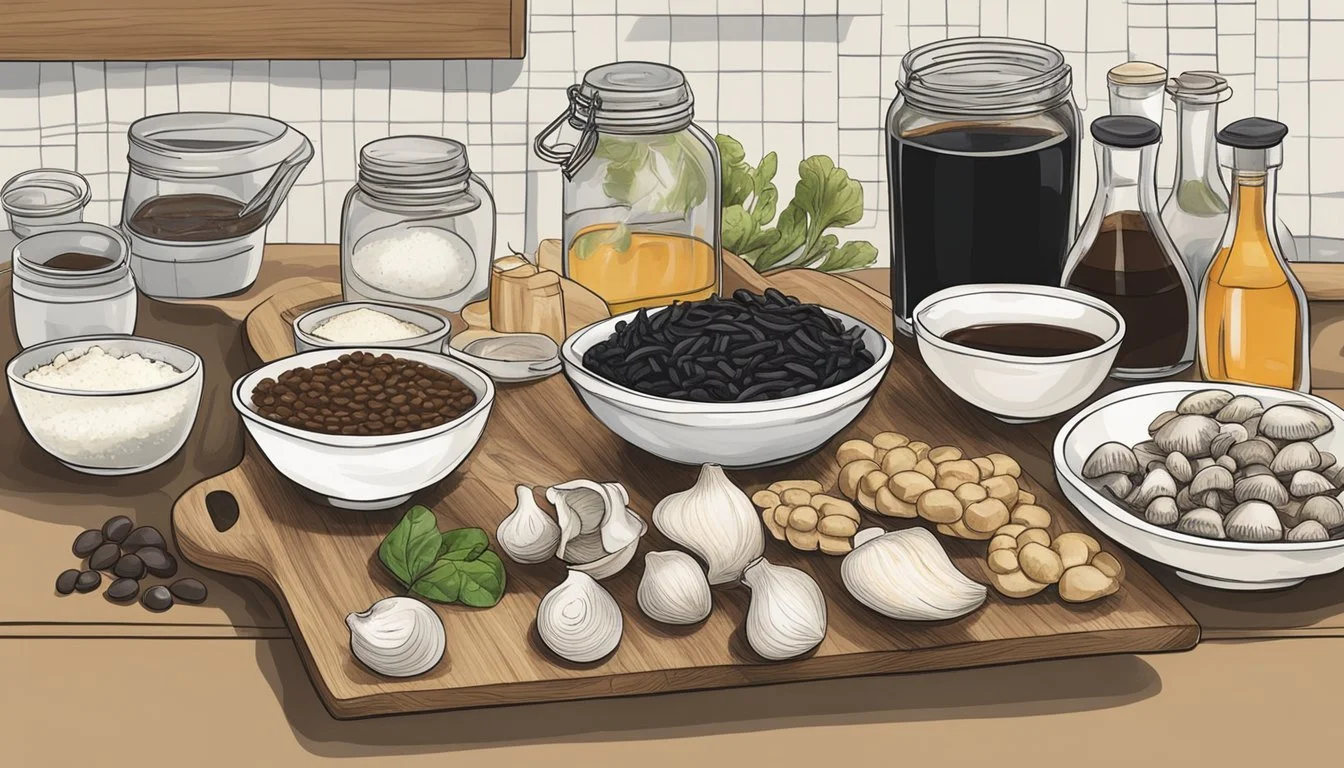Oyster Sauce Substitutes
Top Alternatives for Your Cooking Needs
Oyster sauce is a popular ingredient in Asian cuisine, known for its complex balance of saltiness, sweetness, and umami flavor. Typically made from oyster extracts simmered with salt and sugar, it provides a rich savory depth to stir-fries, marinades, and glazes. However, not everyone can consume oyster sauce due to dietary restrictions, allergies, or simply because they have run out of this staple ingredient in their kitchen.
The culinary world thrives on adaptability, leading to the development of various oyster sauce substitutes that can mimic its unique flavors or contribute their own distinct taste profiles to a dish. These alternatives range from other condiments like fish sauce or soy sauce, which are readily available in most kitchens, to more specialized ingredients like vegan mushroom sauce, which caters to those following a plant-based diet. Each substitute offers a different balance of flavors that can work well in recipes calling for oyster sauce, depending on one’s individual taste preferences and dietary needs.
Understanding the properties of oyster sauce helps in selecting the right substitute when necessary. For a similar consistency and sweetness, teriyaki or sweet soy sauce, known as kecap manis, can be a fitting stand-in. Meanwhile, fish sauce can replace the umami element but may require an adjustment in the amount used due to its stronger fishy taste and higher salt content. Whichever substitute is chosen, it should harmoniously complement the other ingredients in the dish, keeping the intended flavor profile of the recipe intact.
Understanding Oyster Sauce
Oyster sauce is a fundamental condiment in Asian cuisine, renowned for its umami flavor and its versatility in dishes ranging from stir-fry to noodles. It's essential for anyone looking to replicate authentic Asian dishes or seeking to understand their flavor profiles.
Origins and Production
Oyster sauce originated in Guangdong province, China, in the late 19th century. Its invention is attributed to a tea stall owner named Lee Kum Sheung, who accidentally let a pot of oysters simmer for too long, resulting in a thick, brown sauce. This happy mistake gave birth to oyster sauce production, which has since become a staple in Chinese cooking and beyond.
The production of oyster sauce involves boiling oysters in water until a rich and flavorful broth is created. This broth is then concentrated to deepen its flavors and sometimes thickened with cornstarch. The final product is a dark, syrupy sauce that is typically pasteurized for preservation.
Culinary Uses
In Asian cuisine, oyster sauce is commonly used as a:
Seasoning for stir-fries and meat dishes
Marinade for chicken and other meats
Base for sauces and gravies
Its presence is notable in many traditional dishes, such as:
Beef and broccoli stir-fry
Lo mein noodles
Cantonese chicken
Oyster sauce is valued for its ability to enhance the savory notes of various ingredients without overpowering the primary flavors of the dish.
Flavor Profile
The flavor of oyster sauce is distinctively savory with a hint of sweetness. It can be characterized by:
Umami: The fifth taste sensation, often described as savory or meaty
Saltiness: Contributing to its depth of flavor
Sweet undertones: Providing balance to its richness
For those with a shellfish allergy, it's crucial to find an alternative, as oyster sauce contains shellfish and can trigger allergic reactions. There are various substitutes available that mimic the umami quality without the use of shellfish.
Reasons for Substituting Oyster Sauce
When it comes to cooking, individuals substitute oyster sauce for various reasons that align with their dietary needs or ingredients at hand.
Dietary Restrictions
People who follow vegan or vegetarian diets avoid oyster sauce due to its origin from marine life. They prioritize plant-based alternatives to maintain their dietary principles. Moreover, individuals looking for a gluten-free option may need to substitute oyster sauce, as some brands can contain gluten.
Allergies and Sensitivities
A shellfish allergy is a common concern that necessitates avoiding oyster sauce. Individuals with this allergy must find alternative sauces that don’t pose a health risk. Others may have sensitivities to the high sodium content in oyster sauce and seek lower-sodium options.
Availability Issues
Not everyone can easily access oyster sauce, as it might be less commonly found in certain regions or stores. Home cooks may need to opt for readily accessible ingredients they have in their pantry, especially in moments of time constraint or when specialized stores are not an option.
Soy-Based Sauces
When searching for an oyster sauce alternative, soy-based sauces are a versatile option known for their umami flavor. They offer a balance of saltiness and savoriness that can complement a variety of dishes.
Soy Sauce
Soy sauce, made from fermented soybeans, is the most direct substitute in terms of flavor and accessibility. It's a thin, brown liquid that imparts a salty, umami taste. For health-conscious individuals, low-sodium variants of soy sauce provide a similar flavor with less salt content.
Standard Soy Sauce: Traditional, versatile condiment used in numerous cuisines.
Low-Sodium Soy Sauce: Offers a similar taste with reduced salt levels.
Tamari
Tamari is a Japanese sauce, similar to soy sauce but typically gluten-free and with a richer, less salty flavor. It's produced with a higher concentration of soybeans as compared to wheat, making it ideal for those with dietary restrictions.
Gluten-Free Option: Suitable for individuals with gluten intolerance.
Tamari Sauce: A more robust flavor with less salt than traditional soy sauce.
Sweet Soy Sauce
Known as kecap manis, sweet soy sauce combines the traditional soy sauce ingredients with additional palm sugar. It has a thicker consistency and a sweeter flavor profile, making it perfect for recipes that require a bit more sweetness.
Kecap Manis: Infuses a unique balance of sweetness into savory dishes.
Sauces with Umami Quality
When seeking alternatives to oyster sauce, one should consider other sauces rich in umami—the savory fifth taste. The following selections deliver this desirable flavor profile, enhancing dishes with complex, deep notes.
Fish Sauce
Fish sauce is a liquid condiment derived from fermented fish, offering a salty, savory punch. Rich in umami, it can replace oyster sauce using a 1:1 ratio, with a dash of sugar added to mimic the subtle sweetness of oyster sauce.
Worcestershire Sauce
Worcestershire sauce, another umami-laden condiment, boasts a complex flavor palette due to its ingredients including tamarind and anchovies. (What wine goes well with anchovies?) Its taste is tangier and less sweet than oyster sauce, but it can be used in similar quantities to introduce a depth of flavor to various dishes.
Teriyaki Sauce
Teriyaki sauce combines soy sauce with other ingredients such as mirin, sugar, and ginger, creating a balance of sweet and savory with a glaze-like consistency. To substitute for oyster sauce, one can use teriyaki sauce in a reduced volume, approximately two teaspoons of teriyaki for every tablespoon of oyster sauce.
Hoisin Sauce
Made from a base of fermented soybeans, hoisin sauce carries a sweet and tangy profile with a hint of garlic. It delivers the umami quality with a thicker consistency and can be used in place of oyster sauce to complement stir-fries, marinades, and dipping sauces.
Vegan and Vegetarian Substitutes
For those seeking plant-based alternatives to oyster sauce, there are several savory options that mimic the rich umami flavor of the original. Each substitute offers unique characteristics to suit various dietary preferences.
Mushroom Broth
Mushroom broth, particularly when made from shiitake mushrooms, provides a profound umami flavor akin to oyster sauce. To create a homemade version, one can simmer dried shiitake mushrooms in water, allowing the savory notes to concentrate. This results in a vegetarian and vegan-friendly broth that functions well as a base for sauces.
Key Ingredients: Dried shiitake mushrooms, water
Preparation: Simmer mushrooms in water until the broth becomes flavorful
Uses: Base for vegan sauces, seasoning for vegetables
Vegetarian Oyster Sauce
Vegetarian oyster sauce, sometimes labeled as "vegan oyster sauce," is typically made from mushrooms such as shiitakes. It is a direct substitute for traditional oyster sauce, designed to closely match the consistency and taste.
Composition: Shiitake mushrooms, soy sauce, sugar, and seasonings
Texture: Similar to traditional oyster sauce
Compatibility: Ideal for stir-fries, marinades, and as a dipping sauce
Coconut Aminos
Coconut aminos, a sauce made from coconut sap and sea salt, is another vegan option. It is less salty and has a slightly sweeter profile than soy sauce, making it a health-conscious substitute that still delivers a savory punch.
Component: Coconut sap, sea salt
Flavor Profile: Mildly sweet, less salty
Application: Suitable for dressings, marinades, and general seasoning
Homemade Alternatives
Creating a homemade substitute for oyster sauce is practical and can yield a delicious alternative using commonly available ingredients like mushrooms and sugar. These homemade variants leverage natural umami sources to replicate the deep, savory flavor profile of traditional oyster sauce.
Homemade Oyster Sauce
One can prepare a simple Homemade Oyster Sauce by using dried mushrooms. Here's a step-by-step guide:
Rehydrate dried mushrooms in warm water for about 20 minutes.
Once rehydrated, finely chop the mushrooms.
Strain the mushroom water and add it to a saucepan.
Incorporate a small amount of soy sauce and sugar to taste, simmering the mixture to integrate the flavors.
Thicken the sauce with a cornstarch slurry (cornstarch mixed with water) to achieve the desired consistency.
Alternative Mixes
For those looking for other options, there are several Alternative Mixes that can serve as a stand-in for oyster sauce:
Fish Sauce and Sugar: Combine fish sauce with a small amount of sugar to balance the saltiness with a hint of sweetness.
Miso Paste and Sugar: Miso paste mixed with sugar can create a rich, savory substitute with a sweet undertone.
Teriyaki Sauce Adjustment: While teriyaki sauce is sweeter, it can be modified with additional ingredients like a dash of soy sauce or a pinch of garlic powder to more closely mimic the taste of oyster sauce.
Anchovy-Based Substitute: Anchovies are a protein-rich ingredient that can be mashed and mixed with garlic and sugar to create a umami-packed alternative, suitable particularly for meat dishes.
Other Condiments and Ingredients
When one doesn't have oyster sauce on hand, various other condiments and ingredients can provide a balance of sweetness and umami to dishes. Exploring these alternatives helps home cooks adapt recipes to available pantry items while maintaining the desired flavor profile.
Mirin
Mirin is a Japanese sweet rice wine that lends a mild sweetness and a slight alcoholic tang to the dishes it's used in. Unlike oyster sauce, it doesn't contribute much umami but can be useful in glazes and marinades. Mirin has fewer calories compared to oyster sauce, and is sugar-rich, which helps in caramelization.
Black Bean Paste
Black bean paste is another flavorful component, offering a robust umami depth reminiscent of oyster sauce. Generally mixed with garlic and onions, it's a key ingredient in many Asian cuisines. Rich in fiber, its nutritional profile differs from oyster sauce, providing a texture that is thicker and more paste-like.
Ketchup and Sugar Mix
To replicate oyster sauce's balance of sweetness and tang, a mix of ketchup and sugar can be utilized. While ketchup imparts a tomato-based tanginess, the addition of sugar helps mimic the mild sweetness of oyster sauce. This substitute is convenient and offers a similar color, albeit a thinner consistency and a distinctively different taste profile.
Additional Considerations
When seeking substitutes for oyster sauce, one must take into account not just taste compatibility, but also how the alternative will affect storage, shelf-life, and nutritional content.
Taste Adjustments
Substitutes may require modifications to achieve a flavor profile similar to that of oyster sauce. For instance, a blend of sweet soy sauce and garlic can add depth, whereas heat must be carefully controlled to not overpower dishes. Fish sauce offers a similar umami character but is stronger and saltier, often necessitating dilution or a lesser quantity.
Storage and Shelf Life
Substitute sauces differ in their preservation. Most store well in the fridge, extending their shelf life. However, homemade replacements, especially those with fresh ingredients like garlic, must be refrigerated and typically have a shorter shelf life due to the absence of preservatives.
Nutritional Aspects
Alternative sauces can vary significantly in their calorie and nutrient content. For example, a tablespoon of fish sauce may contain about 7 calories, while the same amount of teriyaki sauce, which is often higher in sugar, may have more calories. Fiber content is usually negligible in these sauces. Always check labels for detailed nutritional information, particularly if managing dietary restrictions or calorie intake.
Pairing with Dishes
When considering oyster sauce substitutes, it's essential to understand how different alternatives pair with various dishes. The goal is to maintain the balance of flavors that oyster sauce typically provides, such as umami, sweetness, and a touch of saltiness.
Marinades and Dipping Sauces
For marinades and dipping sauces, teriyaki sauce can serve as a quick substitute, imparting a similar sweet and tangy profile. Vegetarians or vegans might opt for a mixture of soy sauce and a touch of molasses to achieve that umami-rich base.
Teriyaki Sauce: 2 teaspoons as a substitute for 1 tablespoon of oyster sauce.
Molasses + Soy Sauce Mix: For a vegan option, blend with attention to desired sweetness.
Stir-Fries and Noodles
In stir-fries and noodles, especially found in Thai and Chinese cuisine, fish sauce or a homemade mixture of soy sauce, sugar, and chopped mushrooms can provide the depth of oyster sauce.
Fish Sauce: Use sparingly to not overpower with saltiness.
Soy Sauce Mushroom Blend: Combine soy sauce, a pinch of sugar, and finely chopped rehydrated mushrooms.
For vegetarians, hoisin sauce can be a valuable alternative in Chinese brown sauce, offering that thick consistency and a similar color profile.
Hoisin Sauce: An excellent option for thickness and color in vegetable stir-fry dishes.
Meat and Vegetable Dishes
For meat and vegetable dishes, Worcestershire sauce, though thinner, can mimic the complex flavors of oyster sauce when used as a glaze or a seasoning.
Worcestershire Sauce: Provides a similar umami punch; adjust quantities based on preference.
It’s worth noting that each substitute will bring a slightly different character to dishes, so one should experiment to find the perfect pairing.






